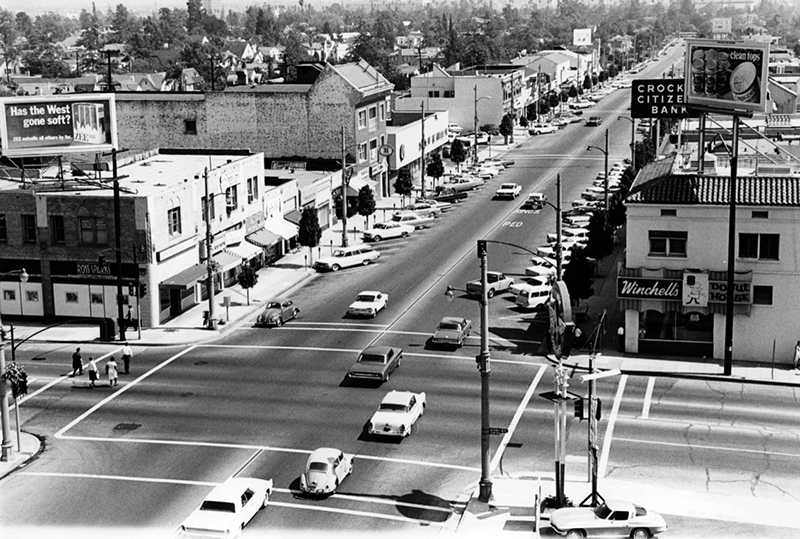Larchmont Village, nestled in the heart of Los Angeles, California, is a quaint and vibrant neighborhood that exudes a unique blend of historic charm and modern vitality. This historic district has a rich history dating back to the late 19th century, and its evolution through the years has shaped it into a beloved community cherished by both residents and visitors.
In 1863 Major Henry Hancock purchased what was previously the eastern portion of the original Rancho La Brea area. His son, G. Allan Hancock, subdivided the land creating what is now Hancock Park. The 1920's saw a boom in palatial two-story residences by important architects of the era, laying the foundation for the neighborhood's distinctive configuration. Residential homes were constructed showcasing their architectural elegance, with many reflecting period revival styles such as Tudor Revival, English Revival, Spanish Colonial Revival, Mediterranean Revival and American Colonial Revival.

Larchmont Village's focal point is undoubtedly Larchmont Boulevard. Originally known as Glenwood Street, it became Larchmont Boulevard in 1912. By the 1920's Larchmont had become a streetcar suburb. The Boulevard underwent a transformation in the 1920s thanks to Julius La Bonte, a developer from the midwest. The transformation attracted businesses, and soon after, a variety of shops, restaurants, and cafes flourished. His daughter, Charlotte La Bonte Lipson, told the Larchmont Chronicle in a 1991 interview about her father's founding of the street: He Always saw it as a service street for the carriage trade of Windsor Square and Hancock Park. It's considered to be the first neighborhood shopping center in Los Angeles.
Throughout its history, Larchmont Village has fostered a strong sense of community. Residents have actively engaged in preserving the neighborhood's historic character, leading to the establishment of the Larchmont Village Neighborhood Association. This organization works to maintain the unique architectural features and green spaces that define the area.
The neighborhood's commitment to culture and the arts is evident in its various cultural events and festivals. The Larchmont Family Fair, an annual event, draws families from all over Los Angeles for a day of entertainment, food, and community bonding. Additionally, the Larchmont Farmers Market provides a space for local farmers and artisans to showcase their goods, reinforcing the neighborhood's emphasis on community and supporting local businesses.
In the 21st century, Larchmont Village continues to thrive as a sought-after residential destination and a hub for local commerce. The balance between preserving historical elements and adapting to modern times is evident in the neighborhood's architecture, boutiques, and eateries. Larchmont Boulevard remains a symbol of this balance, offering a unique shopping and dining experience that honors the past while embracing the present.
Larchmont Village's historical significance is acknowledged by its designation as a Historic Preservation Overlay Zone (HPOZ) by the city of Los Angeles. This designation reflects the commitment of both residents and local authorities to safeguard the neighborhood's architectural heritage and ensure its longevity for generations to come.
Larchmont Village's story is one of transformation, preservation, and community. Its historic charm, combined with its contemporary allure, makes it a cherished neighborhood that stands as a testament to the dynamic nature of urban evolution while holding onto its deep-rooted past.
Learn more about the History of Larchmont in the book:
Images of America, Larchmont, by Patricia Lombard. Available at Chevaliers Books Store.

1964: Larchmont Medical Building developed by Owen Properties Inc.
All images courtesy of Images of America, Larchmont by Patricia Lombard


 Larchmont Village's focal point is undoubtedly Larchmont Boulevard. Originally known as Glenwood Street, it became Larchmont Boulevard in 1912. By the 1920's Larchmont had become a streetcar suburb. The Boulevard underwent a transformation in the 1920s thanks to Julius La Bonte, a developer from the midwest. The transformation attracted businesses, and soon after, a variety of shops, restaurants, and cafes flourished. His daughter, Charlotte La Bonte Lipson, told the Larchmont Chronicle in a 1991 interview about her father's founding of the street: He Always saw it as a service street for the carriage trade of Windsor Square and Hancock Park. It's considered to be the first neighborhood shopping center in Los Angeles.
Larchmont Village's focal point is undoubtedly Larchmont Boulevard. Originally known as Glenwood Street, it became Larchmont Boulevard in 1912. By the 1920's Larchmont had become a streetcar suburb. The Boulevard underwent a transformation in the 1920s thanks to Julius La Bonte, a developer from the midwest. The transformation attracted businesses, and soon after, a variety of shops, restaurants, and cafes flourished. His daughter, Charlotte La Bonte Lipson, told the Larchmont Chronicle in a 1991 interview about her father's founding of the street: He Always saw it as a service street for the carriage trade of Windsor Square and Hancock Park. It's considered to be the first neighborhood shopping center in Los Angeles.








